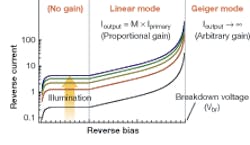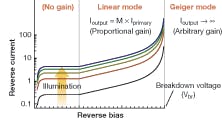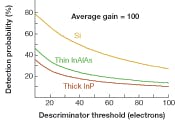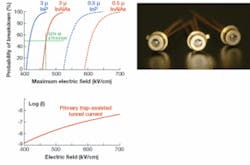Photodiodes: Single-photon-counting APDs operate in the near-infrared
Linear- and Geiger-mode avalanche photodiodes made of III-V compound semiconductors will operate in the eye-safe region; the linear-mode versions will also offer photon-number discrimination.
GEORGE WILLIAMS
Single-photon counting poses considerable demands on detector design and fabrication. Although the actual absorption of each individual photon is a random event that obeys Poisson’s distribution, a 1 W beam of 1540 nm light delivers one photon every 1.29 x 10-19 second, on average.
Of course, technologically speaking, no detector responds on such a short time scale, so the granular nature of strong optical signals manifests itself as shot noise on a continuous signal rather than discrete pulsing of the signal itself. Only in the limit of weak signals-5.16 pW at 1540 nm corresponds to an average of one photon every 0.25 ns-can one speak of a detector “counting” the arrival of individual photons. Extremely weak signals on this order are characteristic of laser-radar returns from distant targets, the fluorescence of rarified species in spectroscopic experiments, semiconductor testing via clock-induced emissions, and data in certain quantum-information applications.
Near-IR photon counting
Photon-counting applications in the near-IR (NIR) are dominated by two categories of technology: tubes and avalanche photodiodes (APDs). Tubes have the merit of extremely low noise, but in the NIR they suffer from fairly low quantum efficiency on the front end. Tubes for the NIR also suffer from lifetime and reliability issues resulting in degradation of quantum efficiency over time. In contrast, APDs can have high front-end quantum efficiency (on the order of 80%) in the NIR, and they boast rugged monolithic solid-state construction with reported lifetimes in excess of 105 hours of continuous operation. However, the NIR photon-counting efficiencies demonstrated to date have been low, typically less than 20%-as have been the maximum reported count rates (less than 15 MHz). This article reviews some recent developments in NIR photon-counting APD technology, and looks at the prospects for the immediate future.
To achieve low dark-count rates and high single-photon quantum efficiency, one would like to have several attributes: APDs that have low primary dark current (less than 1 pA), low trap density in the depletion region, short detrap time (less than 10% of the interpulse time interval), and a multiplication region with a favorable ionization coefficient ratio.
To detect a single photon, a photodiode must generate a current pulse that is large enough to register on external readout circuitry. An APD can use avalanche multiplication to do this in two ways. When operated below the breakdown voltage of the device’s junction, the impact ionization chain initiated by a primary photocarrier eventually terminates, resulting in a finite number of secondary carriers and some average value of current gain. This is called “linear mode” operation, because the reverse current of the APD is, on average, proportional to the strength of the optical signal (see Fig. 1). Alternatively, if the APD is biased above breakdown, then there is a chance that the impact ionization chain initiated by a primary photocarrier is self-sustaining, in which case the current that ultimately flows is determined by the circuit operating the APD rather than the optical signal strength. This is called “Geiger mode” operation.
null
Linear-mode photon- counting APDs
To date, only Geiger-mode photon counting has been demonstrated in the NIR. The reason is that the semiconductor material systems from which it is most convenient to manufacture NIR APDs-typically those that are lattice-matched to an InP (indium phosphide) substrate and that can accommodate the In0.53Ga0.47As (indium gallium arsenide) absorber necessary to receive NIR light efficiently-have naturally high values of excess multiplication noise.
Briefly, the variance of the linear gain of an APD depends upon the statistics of the impact ionization process inside it; that, in turn, is a function of the material’s band structure. Unfortunately, the distribution of linear gain in an APD is not at all Gaussian. Instead, it is characterized by the McIntyre distribution, which is heavily skewed toward low gains for weak signals. The practical upshot is that if the multiplication process is “noisy,” then in most cases only a handful of secondaries will be generated, even when the average gain is high. For instance, an InP multiplication layer operated at an average gain of 100 will output more than 60 electrons for an input of one primary photoelectron only 14% of the time. This is clearly a problem if the readout-amplifier noise floor is 60 electrons, and the receiver cannot distinguish the output of the APD from circuit noise. In comparison, a silicon APD operated under the same conditions can achieve detection 39% of the time.
Silicon is attractive from the standpoint of avalanche multiplication, but its response beyond 1 µm is extremely poor. Attempts to manufacture in high yield reliable hybrid detectors in which an InGaAs absorber is fused to a silicon multiplying junction have not born fruit thus far. Silicon is therefore not a good prospect for high-efficiency photon counting in the eye-safe portion of the NIR.
The natural properties of III-V compound-semiconductor alloys commonly used in the NIR do not compare well to silicon (see Fig. 2). Their chief advantages are the ubiquitous infrastructure of telecommunications-component manufacturers, their compatibility with efficient InGaAs NIR absorbers, and their flexibility. This last trait-flexibility-will be key to their future use in linear-mode photon-counting systems.
In recent years, university researchers have demonstrated a set of design techniques collectively called impact-ionization engineering (I2E), which suppresses the avalanche noise in materials such as InAlAs (indium aluminum arsenide) below the level characteristic of the bullk material. Most forms of I2E involve controlling avalanche-layer thickness, composition, and doping in such a way as to enhance the contrast between the electron and hole ionization rates, and promote spatial correlation of impact ionization events. This degree of control is feasible because of the epitaxial precision afforded by the growth technologies used to manufacture III-V compound-semiconductor wafers.
Thus far, the noise suppression demonstrated by I2E techniques has been limited to relatively low gains. This apparent limitation stems from the fact that elementary applications of I2E rely on preventing some of the longer, statistically outlying impact ionization chains that would otherwise occur, so as to narrow the distribution of the gain. Multiplication noise can be suppressed by rejecting these longer chains, but doing so also limits the gain of the APD. Fortunately, this limitation is well understood, and can be overcome with more advanced I2E design strategies that promote correlation between ionization events without placing strong restrictions on the length of the ionization chains.
Geiger-mode photon-counting APDs
Linear-mode NIR photon counting is on the horizon, but Geiger-mode photon counting is already here-it just has some significant limitations. All of these limitations are related to traps. Traps are localized energy levels in the “forbidden” gap between the conduction- and valence-band edges of the semiconductor, and they result from most any imperfection in or interruption of its crystal lattice. Common varieties include atomic impurities, substitutions, vacancies, morphological features like clusters, defects such as dislocations, surfaces, and interfaces. Traps harm both linear and Geiger APDs by contributing dark current that leads to false detection events in photon-counting applications. Traps also severely limit the maximum rate at which a Geiger APD can be operated.
The dark-count rate of a III-V NIR APD comes from two main sources: generation-recombination (G-R) leakage in the narrow-gap InGaAs absorber, and trap-assisted tunneling in the wide-gap multiplication layer. Generation-recombination leakage is primarily a function of temperature, but the trap-assisted tunnel rate is a strong function of electric-field strength (see Fig. 3). Accordingly, the dark-count rate can be suppressed by cooling the detector, and by designing APDs that operate with lower internal electric-field strengths. The ionization rate in an APD is an exponential function of the electric-field strength, so thicker multiplication layers are required to get the same amount of gain at a reduced field strength. Thick layers are not an attractive option for I2E linear APDs, but-within some practical limits imposed by background doping levels-are a practical solution for Geiger APDs.
Cooling Geiger APDs is less effective than cooling linear APDs because of the impact of traps on the maximum count rate. Unlike a linear APD, in which a current of a few hundred electrons can constitute a detection event, significant currents flow through Geiger APDs during breakdown-enough to fill the trap states in the junction. Subsequently, as the trap states return to their equilibrium population by re-emitting the trapped carriers, a Geiger APD experiences a strong enhancement of its dark-count rate immediately following a detection event. This is called “afterpulsing.” Insofar as it takes longer to restore equilibrium the colder the detector is, afterpulsing actually gets worse as the detector is cooled to combat G-R leakage. The necessity of holding Geiger APDs in quench following every detection event while the traps depopulate is why count rates in excess of 15 MHz have seldom been reported. In contrast, a linear-mode photon-counting APD should be able to operate with gigahertz-scale bandwidth, as linear telecommunications APDs do.
Eye-safe wavelengths are coming
Avalanche-photodiode photon counters that operate efficiently at the eye-safe NIR wavelengths of cheap telecommunications diode lasers will soon be a reality. In the near term, better NIR Geiger APD performance should result from designs with thicker multiplication layers, although the maximum count rate of this technology-and the inability to resolve signal strength (photon number)-remain limitations. Further down the road, application of improved I2E techniques should bring photon counting within reach of linear APDs. The advent of NIR-sensitive APDs with multiplication noise comparable to silicon will revolutionize photon counting in this waveband by improving bandwidth by several orders of magnitude and by providing amplitude information from stronger multiphoton signals.
GEORGE WILLIAMS is president of Voxtel, 12725 SW Millikan Way, Suite 230, Beaverton, OR 97005; e-mail: [email protected]; www.voxtel-inc.com.



